At home in Tokyo’s snack bars
Kyoichi Tsuzuki uncovers a world of live karaoke and Swedophiles
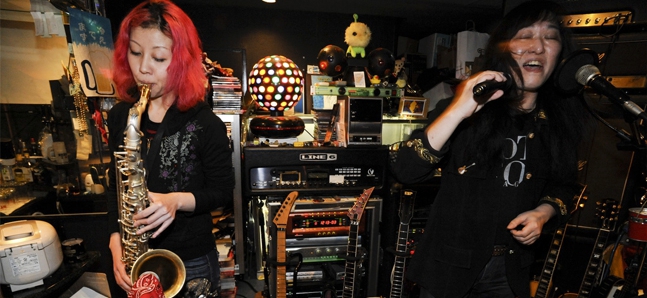
Posted: Fri Feb 01 2013
Every country has a place for people to relax and socialise. London has its pubs, Paris its cafes, New York its bars. In Istanbul you’ll find tea houses and coffee shops, in Bangkok it’s the open-air street stalls. And in Japan, it’s the snack bars.
I’ve never seen any official figures, but estimates put the number of snack bars here at between 100,000 and 200,000. That works out at over 2,000 per prefecture – and I’ll bet that almost all of them have karaoke. Go to any snack bar on any given night and, mingled with the sound of ice chinking in glasses of shochu, you’ll probably hear renditions of classic oldies like ‘Kassai’, ‘Tsugunai’, ‘Ginza no Koi no Monogatari’ and ‘Tsugaru Kaikyo Fuyugeshiki’. The mainstream media might not like to admit it, but this is where the true songs of Japan live on.
Snack bars are said to have been born in the run-up to the 1964 Tokyo Olympics, when Japan sought to create a more reputable form of late-night drinking establishment that it wouldn’t mind showing to the outside world. (Really: you should’ve seen the dingy joints that people used to drink in.) The ‘snack’ part stemmed from the fact that these places would serve light food alongside the drinks, though never anything too fancy. Of all the types of eatery regulated by Japan’s Law on Control and Improvement of Amusement Business (known as fueiho for short), snack bars are said to be the easiest to set up, even for complete newbies.
No matter how bad the global economy gets, Japan’s gurume foodie boom doesn’t show any signs of stopping. Go to any bookshop and you’ll discover no end of culinary guides, but you’d struggle to pick out a single one that covers snack bars. And yet, for Japanese gents of a certain age, the phrase ‘nomi ni iku’ (‘I’m off out for a drink’) almost invariably means ‘sunakku ni iku’ (‘I’m off to the snack bar’). The reason for the lack of coverage is actually pretty simple: these just aren’t the kind of places that you’d visit after finding them online or in a book.
Snack bars don’t serve any special drinks – usually just beer and shochu – and the food menu normally consists of dried nibbles and not much else, although you can often request something more substantial, like a bowl of yaki-udon (fried noodles), if you get really hungry. The interiors tend to be run-of-the-mill, the karaoke systems are never particularly fancy, there aren’t any glamorous girls to look at and, unlike at chain izakaya, there aren’t any rock-bottom prices to lure potential customers.
Such enticements simply aren’t relevant at snack bars. What makes or breaks them is the character of the owner, referred to as ‘mama’ if it’s a woman or ‘master’ if it’s a man. The establishments that do best are those with an outstanding mama or master – someone who can attract a regular clientele that becomes a kind of family. This is why they’re so hard to enter: it might be difficult to appreciate if you’ve never been to one before, but the experience of going to an unfamiliar snack bar for the first time is a lot like turning up uninvited at someone’s house.
You can make life easier for yourself by using the phrase that’s customary when visiting a stranger’s home, ‘gomen kudasai’ (sorry to disturb you), followed by ‘suimasen, agatte ii desu ka’ (mind if I join you?). One of the regulars will probably welcome you with something like ‘ma, ippai nominayo’ (sure, have a drink) and usher you to a place at the kotatsu... er, I mean the bar. Within a few hours you’ll be tipsy, and before you realise it you’ll be one of the family yourself. A few visits later and they’ll probably be inviting you to weekend BBQs and bowling trips – that’s just the way it works at snack bars.
Of course, if they were just places to drink and sing, people wouldn’t bother going. The appeal of a good snack bar is different to that of regular izakaya, clubs or karaoke boxes, and something that’s hard to explain to the uninitiated. But, as with the love hotels I wrote about in a previous article, they’re an intrinsic part of modern Japanese culture.
There’s an enormous number of snack bars here in Tokyo, and I’ll introduce two of them here – both of which I patronise myself. Neither is what you’d call a ‘typical’ snack bar, and they’re both amenable to foreign customers. If you feel a bit nervous when you visit (as I’m sure I would), just mention that you read this article and they should welcome you with open arms, setting you up for the kind of experience that you’d never get in any other type of bar.
Skåne, Shibuya

Just look for the place with the bright blue door – it's hard to miss
Hidden in a building on the Aoyama side of Shibuya Station, 30-year-old snack bar Skåne takes its name from the southernmost county in Sweden – and the connections don’t end there. The interior is painted in the blue and yellow of the Swedish flag, with a counter shaped like the hull of a Viking ship and paintings of Scandinavian scenes on the walls. Beautiful European women ply the customers with Zubrowka vodka and imported Swedish cheese and crackers. Oh, and they also have karaoke.
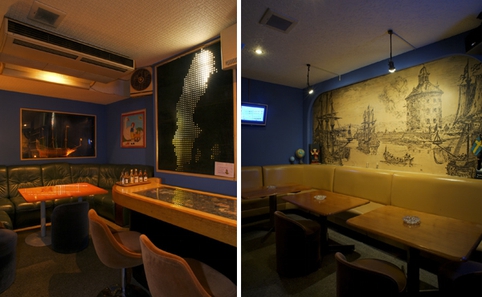
Swedish paintings and a stylised image of the country's map adorn the walls at Skåne
Shibuya + Sweden + Karaoke? You’d be surprised how well it works. The mama, Kazuko Hara, used to live in Sweden, and for the first two decades of the bar’s life she only ever employed Swedish girls – over 800 in total. (Changes in Japan’s visa regulations meant that she had to rethink this policy, though she still only hires barmaids from overseas.)
‘A lot of our regulars work for trading companies or have lived abroad, so it’s a comfortable environment for people on working holidays,’ she says. ‘We also help arrange accommodation, and the Swedish employment agencies actually used to refer people to us in the past. Many of the girls who’ve worked here still write, even after they’ve gone back home.’ Sure enough, she keeps a box stuffed full of picture postcards and photos that she’s received, plus clippings from Swedish newspaper articles about the bar.
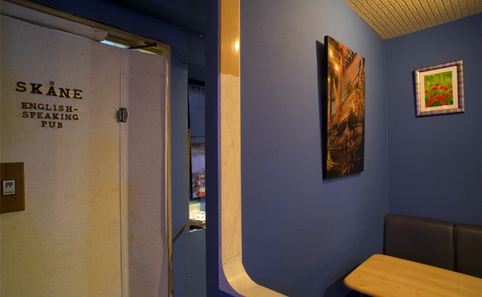
Yup: they speak English here too

This is all you'll be eating and drinking tonight: chilled Zubrowka, Swedish cheese and crackers

Be sure to check the clippings from Swedish newspapers on the way to the toilet
To keep everything as simple and reasonable as possible – two qualities that the mama likes – there’s basically just one type of alcohol and one type of snack on offer (although customers are welcome to bring their own food too). Regardless of how much you drink, the cover charge is a flat ¥3,500, plus a 10 percent service charge – ‘which is why we always ask customers to tot up their own bills,’ says the mama with a laugh.
Head here and you’ll be in for a real Shibuya treat.
3F, 1-15-16 Shibuya, Shibuya-ku. Map and opening hours
Studio Himawari, Kabukicho

Kabukicho: just looking at the place makes you feel a little bit seedier
I got my first introduction to Studio Himawari when a barman at an all-night joint in Shinjuku Nichome invited me to come to the place where everyone went to drink after they finished work. Himawari opened in 2004, on the fifth floor of a run-down Kabukicho building that shares its street with karaoke boxes, hostess bars and other nocturnal enterprises. As you get out of the elevator, you’re confronted by some ripped wallpaper that looks like it dates back to the ’70s, while Himawari’s drab exterior doesn’t inspire much more confidence. If I hadn’t been invited, I doubt I ever would have dared go in.

The master's impressive guitar rack. And no, you're not allowed to play them
The atmosphere changes as soon as you set foot inside, where you’ll immediately notice the hefty guitar amps and rack of electric guitars. As you’d expect from a place with the word ‘Studio’ in its name, Himawari is a snack bar for music lovers. But that’s not all: as you order a drink and reach for the karaoke controller, don’t be surprised if the master picks up one of the guitars from his collection and starts playing along, often with saxophone accompaniment from the mama. Talk about live karaoke!
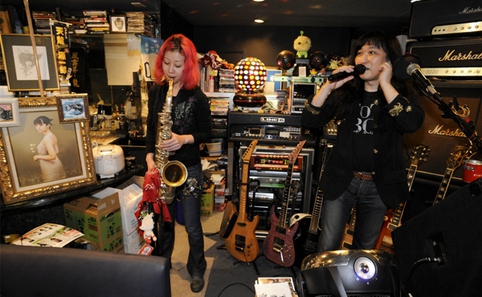
Studio Himawari's mama and master strut their stuff. You wouldn't get this at Shidax
Himawari’s master, Takuya Tachibana, was a teenage rock fan with dreams of becoming a professional musician, but after graduating school he began working in clubs in Akasaka and Roppongi instead. He later moved on to clothes shops in Omotesando and Harajuku and eventually started his own discount store business, but things didn’t pan and, in his own words, he ‘ended up escaping to Kabukicho.’ After he’d worked at a friend’s bar for a while in order to keep a low profile, a few people grouped together and helped him start Himawari, allowing him to get back on track and pay off a few outstanding debts.

Well-known artists and illustrators have gifted work to Studio Himawari in the past
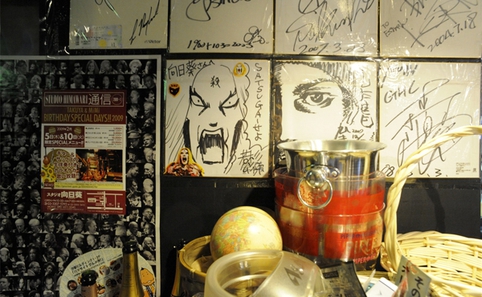
Signatures of manga artists and professional wrestlers adorn the walls
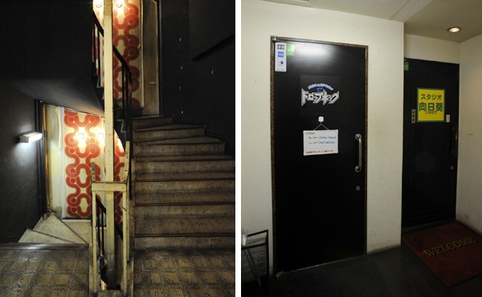
Left: Dated '70s wallpaper in the stairwell. Right: The dowdy exterior is more than a little off-putting
Himawari opens at 10pm and supposedly closes at 7am, but they usually stay open until around noon (assuming there are enough people there – and there usually are); they’ve even been known to keep going until noon on the following day. Takuya and his mama accomplice, Mimi, manage to conjure up food like grilled fish and hearty ‘napolitan’ spaghetti in between settling accounts, performing and refilling customers’ drinks. You’ll sometimes see Takuya top someone’s glass up with his right hand while still strumming with his left – just looking at these two in action puts me in the mood for a rendition of ‘A Hard Day’s Night.’
I’ve introduced quite a few foreign friends to this place in the past, and their reaction is almost always the same: after insisting that there’s no way they’re singing karaoke, within half an hour they’re poring over the remote control, deciding which song to sing next. Preferably one with a long guitar solo in it.
5F, 1-4-12 Kabukicho, Shinjuku-ku. Map and opening hours
Kyoichi Tsuzuki’s official website: www.roadsiders.com
Tags:
Tweets
- About Us |
- Work for Time Out |
- Send us info |
- Advertising |
- Mobile edition |
- Terms & Conditions |
- Privacy policy |
- Contact Us
Copyright © 2014 Time Out Tokyo












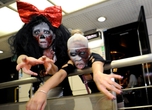

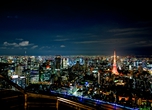

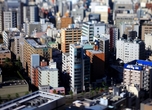
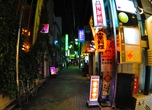
Add your comment